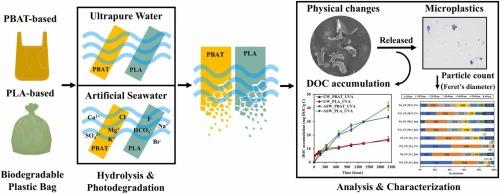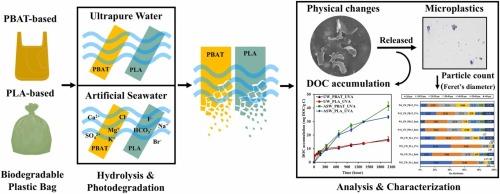商用PBAT和pla基塑料袋在水中产生可生物降解的微塑料:UVA和水介质的影响
IF 11.3
1区 环境科学与生态学
Q1 ENGINEERING, ENVIRONMENTAL
引用次数: 0
摘要
本研究研究了两种市售的可生物降解塑料袋(主要由聚己二酸丁二酯-对苯二甲酸酯)(PBAT)和聚乳酸(PLA)组成)在30 ± 1 °C的UVA光照和黑暗条件下,在超纯水(UW)和人工海水(ASW)中12周的非生物降解潜力。通过失重、形态变化、羰基指数(CI)、溶解有机碳(DOC)生成、微塑性形成和水分分析来评估降解行为。结果表明,PBAT和PLA在UW下的降解速度比在ASW下更快,UVA光显著提高了降解速率。表面分析表明PBAT的降解主要通过体侵蚀发生,而PLA的降解涉及体侵蚀和表面侵蚀。PBAT经历了大量的失重,而PLA则表现出更快的CI增加,这表明PBAT对水解更敏感。水分析显示pH值波动、DOC释放和微塑料(MPs)的存在,表明正在进行水解和氧化降解。尼罗红(NR)标记和ImageJ分析进一步证实了MPs的存在,确定了各种颗粒形状,主要是碎片和纤维。利用ImageJ进行的MP尺寸和分布分析表明,这两种塑料类型对MP的形成都有显著贡献。总的来说,这些发现表明,市售的可生物降解塑料袋在水生环境中会发生不完全降解,并可能以与传统塑料类似的方式在海水中持续存在。这些结果强调需要进一步研究,以提高生物可降解塑料的设计和环境性能,特别是关于它们在海洋条件下的降解行为。本文章由计算机程序翻译,如有差异,请以英文原文为准。


Generation of biodegradable microplastics from commercially available PBAT and PLA-based plastic bags in water: Impacts of UVA and water medium
This study investigated the abiotic degradation potential of two commercially available biodegradable plastic bags, primarily composed of poly(butylene adipate-co-terephthalate) (PBAT) and polylactic acid (PLA), in ultrapure water (UW) and artificial seawater (ASW) under UVA light and dark conditions at 30 ± 1 °C over a 12-week period. Degradation behavior was evaluated based on weight loss, morphological changes, carbonyl index (CI), dissolved organic carbon (DOC) generation, microplastic formation, and water analysis. Results indicated that both PBAT and PLA degraded more rapidly in UW than in ASW, with UVA light markedly enhancing the degradation rate. Surface analysis revealed that PBAT degradation primarily occurred through bulk erosion, whereas PLA degradation involved both bulk and surface erosion. PBAT experienced substantial weight loss, while PLA showed a more rapid increase in CI, suggesting greater susceptibility to hydrolysis. Water analysis revealed pH fluctuations, DOC release, and the presence of microplastics (MPs), indicating ongoing hydrolytic and oxidative degradation. The presence of MPs was further confirmed by Nile Red (NR) tagging and ImageJ analysis, which identified a variety of particle shapes, primarily fragments and fibers. MP size and distribution analysis using ImageJ demonstrated that both plastic types contributed significantly to MP formation. Overall, these findings suggest that commercially available biodegradable plastic bags undergo incomplete degradation in aquatic environments and may persist in seawater in a manner similar to conventional plastics. These results highlight the need for further research to enhance the design and environmental performance of biodegradable plastics, particularly with regard to their degradation behavior in marine conditions.
求助全文
通过发布文献求助,成功后即可免费获取论文全文。
去求助
来源期刊

Journal of Hazardous Materials
工程技术-工程:环境
CiteScore
25.40
自引率
5.90%
发文量
3059
审稿时长
58 days
期刊介绍:
The Journal of Hazardous Materials serves as a global platform for promoting cutting-edge research in the field of Environmental Science and Engineering. Our publication features a wide range of articles, including full-length research papers, review articles, and perspectives, with the aim of enhancing our understanding of the dangers and risks associated with various materials concerning public health and the environment. It is important to note that the term "environmental contaminants" refers specifically to substances that pose hazardous effects through contamination, while excluding those that do not have such impacts on the environment or human health. Moreover, we emphasize the distinction between wastes and hazardous materials in order to provide further clarity on the scope of the journal. We have a keen interest in exploring specific compounds and microbial agents that have adverse effects on the environment.
 求助内容:
求助内容: 应助结果提醒方式:
应助结果提醒方式:


